An orbital design using
one Earth gravity assist allows STARDUST to capture
cometary dust intact at a low relative speed of
6.1 km/s (as a comparison, Giotto encounter Comet
Halley at a relative speed more than 10 times
higher). With the aid of onboard optical navigation,
the flyby will take place at an encounter distance
as close as a 300 kilometers from the comet's
nucleus. This extraordinary trajectory imposed
a very low post-launch fuel requirement and enabled
launch by a Med-Lite version of the Delta II launch
vehicle.
Mission
Schedule in Brief
+ Launch - February
1999
+ Earth Gravity Assist - January 2001
+ Asteroid Annefrank Encounter - November
2002
+ Comet Wild 2 Encounter - January 2004
+ Earth Return - January 2006
|
The STARDUST spacecraft was launched on February
7, 1999. The first orbital loop was a 2-year path
with a 160 m/s delta-V trajectory correction maneuver
(TCM) near aphelion. This delta-V set up the Earth
swingby that pumped the orbit up to the 2.5-year
loop, which the spacecraft flew by twice. At 198
days before encounter, a delta-V of 71 m/s was
performed to set up the Comet Wild 2 flyby. This
will occur on 2 Jan 2004, at 1.86 AU and 98.5
days past Wild 2 perihelion passage. A 1 AU (Astronomical
Unit) test was performed during June-July 2003
to assess the spacecraft performance for Earth
return enviroment. The spacecraft will approach
the comet at 6.1 km/s from sunside with a 73º
phase angle. Coma fly-through will be on the sun
side at a planned miss distance of 300 kilometers.
Flyby is five years after launch, and Earth return,
two years later.
Altogether, three orbits will be made around the
sun to minimize the delta-V requirements for the
mission so that a Med-Lite version of the Delta
II launch vehicle could be utilized. Also, the
three orbits will maximize the time for favorable
collection of interstellar dust.
Launch Ascent Profile
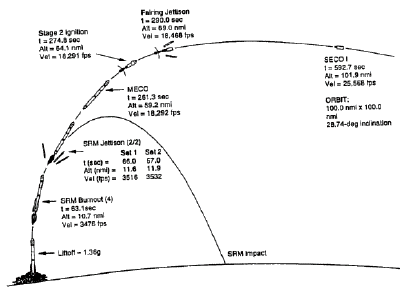
The STARDUST spacecraft was
launched aboard a Med-Lite version of the Delta
II launch vehicle. At about 10 minutes after launch
the spacecraft reached an altitude of 100 nautical
miles and was 100 nautical miles down range.
Upper Stage Launch Ascent Profile
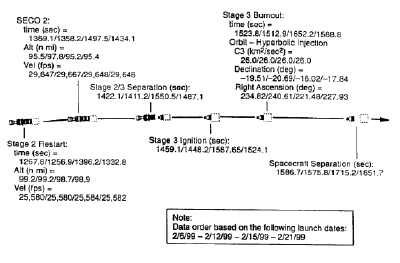
At about 21 minutes after launch
the second stage restarted. Following separation
at about 24 minutes into the flight the third
stage ignited and burned for about 2 minutes after
which the third stage separated and the spacecraft
commenced its cruise for the Earth swingby.
Trajectory
STARDUST's seven-year, three-loop, EGA (Earth
gravity assist) trajectory was designed (1) to
fly by Wild 2 at a low velocity while it is active,
(2) to maximize the time for favorable collection
of interstellar dust, (3) to minimize the C3 (escape
energy from Earth) and delta V requirements for
the mission so that a smaller launch vehicle could
be used, and (4) to have a low velocity relative
to Earth upon return.
+
Full Screen View of the Complete Flight Plan
Trajectory Loop 1
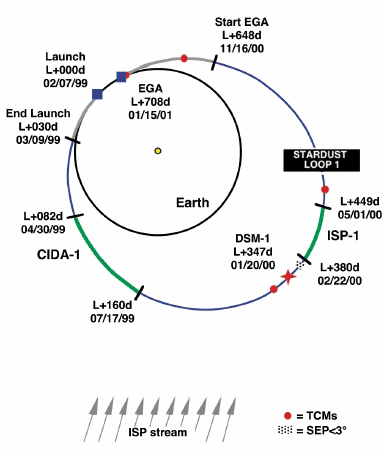
Trajectory Loop 2
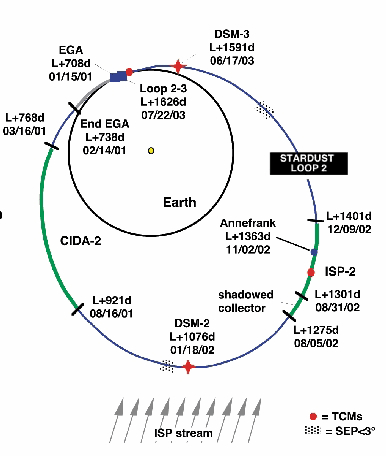
Trajectory Loop 3
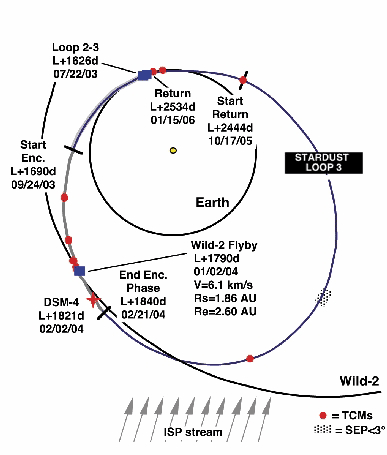
+
Where is Wild 2 Now?
|
